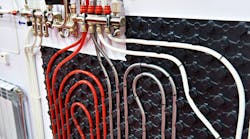Latest from Eatherton
Sponsored
In my last article (June 2018) we’d started to look at the instruments necessary for setting up the boiler. In this, the final article on commissioning, we will discuss the other parameters in need of testing and documentation.
We’ve looked at the need for combustion analyzers and manometers for fuel pressure adjustments. The other meter necessary would be a clamp on amperage meter, for documenting high draw electrical equipment, and a digital voltage mater capable of reading voltages, resistances and low amperages.
Every major electrical component should be tested, adjusted if necessary, and documented. This includes pumps and circulators, whole heat sources (boilers, GSHP’s, ASHP’s etc) and blowers.
The manufacturers of all of these items will produce a product specification sheet which shows what the amperage draw is supposed to be for a given item. It is important to first make certain that the provided voltage is within the manufacturers requirements, because if the voltage is off, the amperage will also be out of specification.
Once voltage is confirmed, it is necessary to create a reasonable “demand” on the system. With variable speed pumps and circulators, again, this is a parameter that may have to wait until it is fairly cold outside in order to create load conditions that are significant enough to test and document.
Even items as small as zone valve motors should be documented as it pertains to documenting their voltage, resistance and amperage draw. Hence the reason for needing a quality digital multi meter to accomplish these tasks. In this tool category, with the exception of the amp meter, I prefer the use of digital multi meters over analogue meters for this purpose. It allows the technician the ability to read and document minuscule conductivity differences, which can equate to major changes in the operation of a given system.
We’d love to think that the technicians who are working for us now, will retire with us, but the truth is, that they are continuously seek higher ground, and may be leaving your employment. Having a permanent record of the commissioning of a system will provide other or future employees a track record of operating conditions whenever necessary.
If there’s a bad wiring connection, or partially cut wires, a good meter will be capable of showing you these differences. On equipment that is using resistive thermistors for temperature or pressure inputs, if the addition of up to 1,000 feet of 18-gauge conductor isn’t taken into consideration, the resultant operation will be affected.
In addition to the obvious need for proper sensor location and means of attachment, in some cases, it is possible and in fact necessary to make offset adjustments to sensors in order to ensure proper and accurate operation. I should note that not all solid-state controls have the ability to allow for sensing element adjustment, and in those cases, you may have to make some overall adjustment to the operation of the system in order to compensate for these differences. It is strongly recommended that these resistances be documented and recorded for future references. A copy should be maintained on site for permanent records, a copy kept in the office to back up the copy left in the field, and in some cases, the architect and general contractor may also need copies of these commissioning reports.
The organization of all of this data is important for many reasons. If, for example, you are taken to court for not performing your job correctly, the documentation will be your best friend in court. I once had a judge tell me that if its’ not in writing, then it is not admissible in a court of law. In other words, if you didn’t document your work in writing, then in the eyes of the court it is hearsay evidence, and not something you can use in your defense.
We’d love to think that the technicians who are working for us now, will retire with us, but the truth is, that they are continuously seek higher ground, and may be leaving your employment. Having a permanent record of the commissioning of a system will provide other or future employees a track record of operating conditions whenever necessary. We’d also like to think that the owners or owners agents would never make any modifications or adjustments to the equipment in the field, but as we all know, that happens on a regular basis, and having a full list of documented equipment conditions during the commissioning process will allow you to show due diligence in bringing the system back into compliance, and letting the consumer know that you have a good handle on the situation, and would prefer that, if adjustments were necessary, that you as the original commissioning agent are being consulted prior to the adjustments being made. This not only avoids a lot of problems in the field, but shields the contractor against any wrongful law suits that may pop up due to someone else fiddling with the system.
By now, hopefully you realize the value and importance of documenting equipment conditions and commissioning these systems. The cost of the equipment necessary is a very important part of doing your job. Without this required instrumentation, really all you can do is to say that the equipment was in a good working order at the time of your leaving the job site, which really doesn’t go deep enough. It also helps to avoid issues in the field that may cost your organization precious profits.
Tune in next month as I go for a ride along with one of todays top notch technicians from Advanced Hydronics, Inc., a well established hydronics contractor serving the Colorado market. Until then, Happy Summer Hydronicing!
Mark Eatherton material, in print and online, is protected by Copyright 2017. Any reuse of this material (print or electronic) must first have the express written permission of Mark Eatherton and CONTRACTOR magazine. Please contact via email at [email protected].
Mark Eatherton
Mark Eatherton material on this website is protected by Copyright 2017. Any reuse of this material (print or electronic) must first have the expressed written permission of Mark Eatherton and CONTRACTOR Magazine.


